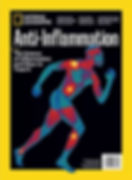National Geographic Study Anti-Inflammation
- carolineblake-syme
- Aug 2, 2024
- 3 min read

In May 2024 a special issue of the prestigious magazine National Geographic was devoted to inflammation. The title chosen was actually Anti – Inflammation and it highlighted many so-called ‘auto’ immune diseases in which inflammation features, such as Rheumatoid Arthritis (RA) and also, of course, multiple sclerosis (MS). All specialists involved in caring for patients with these diseases agree that they start with inflammation.
The internationally recognised Professor Philip B. James MB ChB DIH PhD FFOM Emeritus Professor of Medicine, Chairman of Hyperbaric Oxygen Treatment Trust (HBOTT) kindly analysed this lengthy report and shared his findings in the latest edition of the HBOTT newsletter. We thought that our members and supporters would also find this a fascinating read, so have shared Professor James’ thoughts…
“The article emphasises that inflammation is an immune response that is essential to our lives because it is how the body deals with both infection and tissue injury. Many years ago, I was shown by a Canadian scientist how to see living blood under the microscope – something that is never done by ‘mainstream’ blood specialists because the stains used for blood samples actually kill cells. I saw that the blood of normal healthy people often contains circulating bacteria and sometimes white blood cells can be seen engulfing them. But the same immune white cells also clear up the tissue debris left after a wound that results from an injury. The inflammation having dealt with the problem should stop but if the tissue oxygen levels do not return to normal, the inflammation will continue.
The National Geographic journalists do explain that inflammation may get out of control leading to chronic illness but have yet to discover that it is associated with hypoxia - lack of oxygen - although they have realised that auto immune disease may follow injury.
However, what has yet to be recognised and taught in mainstream medicine is that the inside of blood vessels – the pipes that carry blood can be injured by particles that enter blood vessels may cause the pipes to leak. This is particularly important for the brain and the spinal cord because the blood vessels form a barrier to prevent harmful agents entering the nervous system.
This is where my research started more than fifty years ago – studying the effects of nothing more sinister than bubbles little bigger than red blood cells which are released by decompression in divers - the ‘bends.’ They cause internal damage to small blood vessels and a mild version of the pathology that causes the scars of MS i.e. multiple sclerosis. The editor of the Lancet allowed me 6000 words and 70 references in 1982 to explain this but it was met with silence from neurologists. Still after over 40 years in which patients with MS have run their own treatment in our MS Therapy centres recognised by several governments, the use of oxygen in healing is ignored and sclerosis – the scarring is allowed to continue.
Most people realise that giving oxygen is used for emergencies and this should be the case for the first symptoms that are produced by the inflammation of the brain. As in Covid-19 patients. Boris Johnson as Prime Minister was eventually given 100% in hospital. When asked what saved his life he said “litres and litres of oxygen” but, notably, it was not mentioned by his doctors."
Click here to view a preview of the magazine, available through Amazon.
To find out more about the Hyperbaric Oxygen Therapy available at The Brightwell, please visit www.thebrightwell.org.uk/oxygen-therapy





